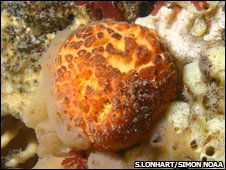
The spicules of sponges viewed under high magnification
|
Sea sponges can beam light deep inside their bodies, and do so using the natural equivalent of fibre optic cables, scientists have found.
Sponges are among the oldest and simplest of Earth's animals.
The discovery that they use such a futuristic light transmission system has therefore delighted researchers.
The finding, made by a German team, is published in the Journal of Experimental Marine Biology and Ecology.
Whereas other animals pass electrical currents around their bodies using nerve cells, sponges appear to be the only animals capable of transmitting light around their bodies in this way, the group says.
This may help explain why some sponges are able to grow so big, and also clear up a long-standing mystery about how other, much smaller organisms are able to live deep within the bodies of large sponges.
Glass skeletons
Sponges mainly live in the sea, and are extremely primitive organisms. They lack muscles, nerves and internal organs, for example, and are essentially a diverse set of cells supported by a hard exoskeleton.
Two of the three major types of sponge build their skeletons using special structures called spicules. These are made from silica and are basically glass rods. Previous experiments suggested that light can pass along these structures.
Now, Franz Brummer, of the University of Stuttgart, and colleagues have proved that living sponges use these internal glass rods as light conductors.

Photosensitive paper was placed inside sponges of the species T. aurantium
|
Light reaching the surface of the sponge is reflected off the insides of each spicule in much the same way light bounces along the inside of a fibre optic cable used to transmit electronic data. In doing so, light is beamed deep into the sponge.
Brummer's team made the discovery using living sponges of the species Tethya aurantium. They collected the sponges from shallow waters off the coast of Croatia, and then transferred them to tanks of seawater.
They then implanted light sensitive paper deep inside each sponge. They did so under dark conditions and then exposed the surface of the sponge to light. When they checked the paper, they found it was covered in spots, which corresponded exactly with where light would exit each spicule.
Shared existence
In a control experiment, the researchers tested another sponge that does not grow using glass spicules. No light entered deep within it, showing that spicules are necessary to transmit the light.
"Sponges are fascinating animals and there're lots about them we are waiting to discover," says Brummer.
He suspects that deep-sea sponges may use giant natural fibre optic arrays to harvest what little light reaches them. "Sponges in the deep sea can form spicules up to one metre long and two centimetres in diameter," he explains.
Beaming light deep inside their bodies may explain why some sponges grow to such large sizes, and develop rounded shapes.
To grow big, sponges need essential nutrients, including carbon, nitrogen and other metabolites. These are provided by smaller organisms such as algae and cyanobacteria, with which the sponges have a symbiotic relationship.
But these smaller organisms need light to survive. Because of this they usually live on the outside of sponges.
In 1994, however, researchers discovered that algae sometimes do live deep within the bodies of sponges, creating a mystery as to how they survive there. The answer, as Brummer's team has now confirmed, is that they live off light beamed down to them.
|
Bookmark with:
What are these?